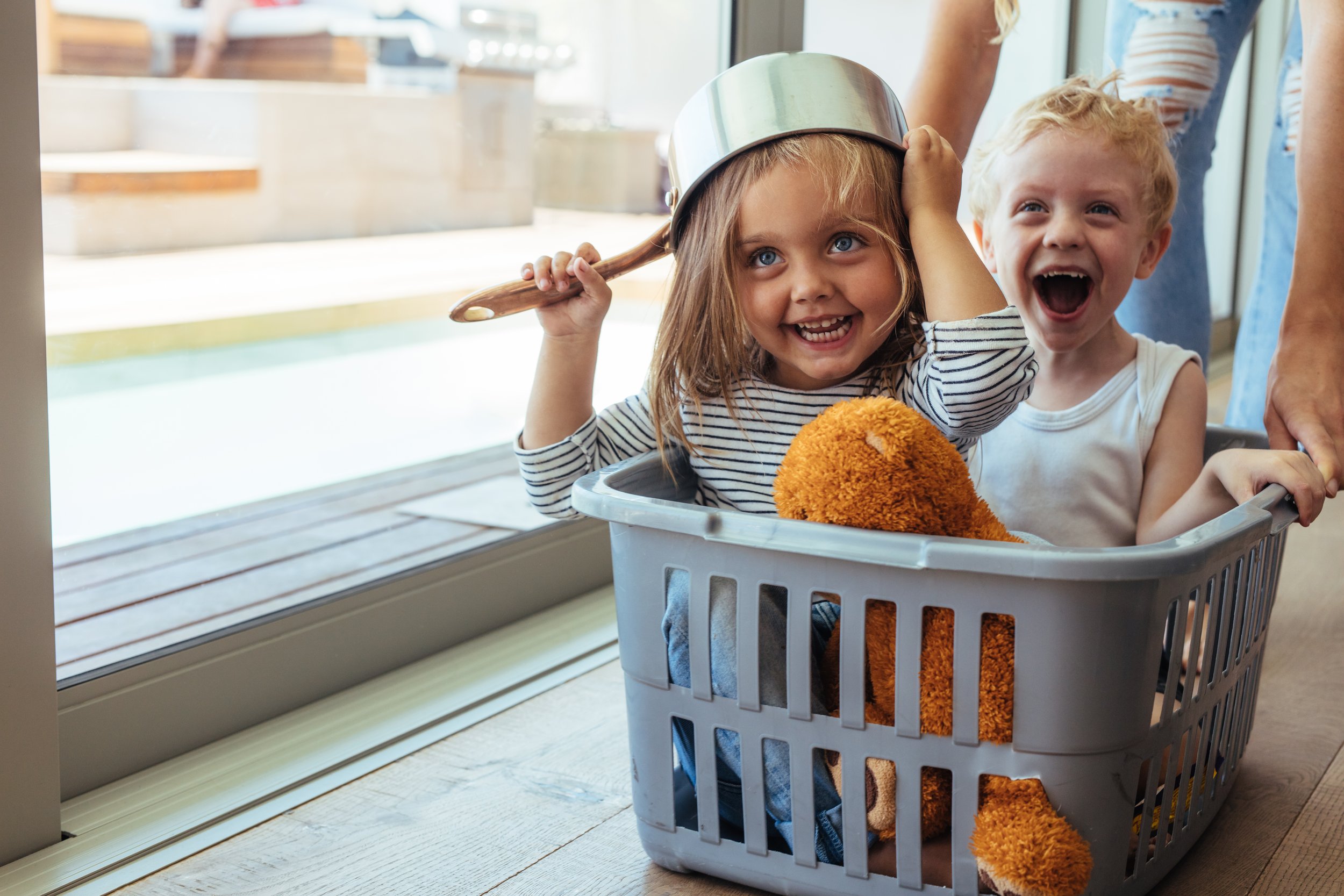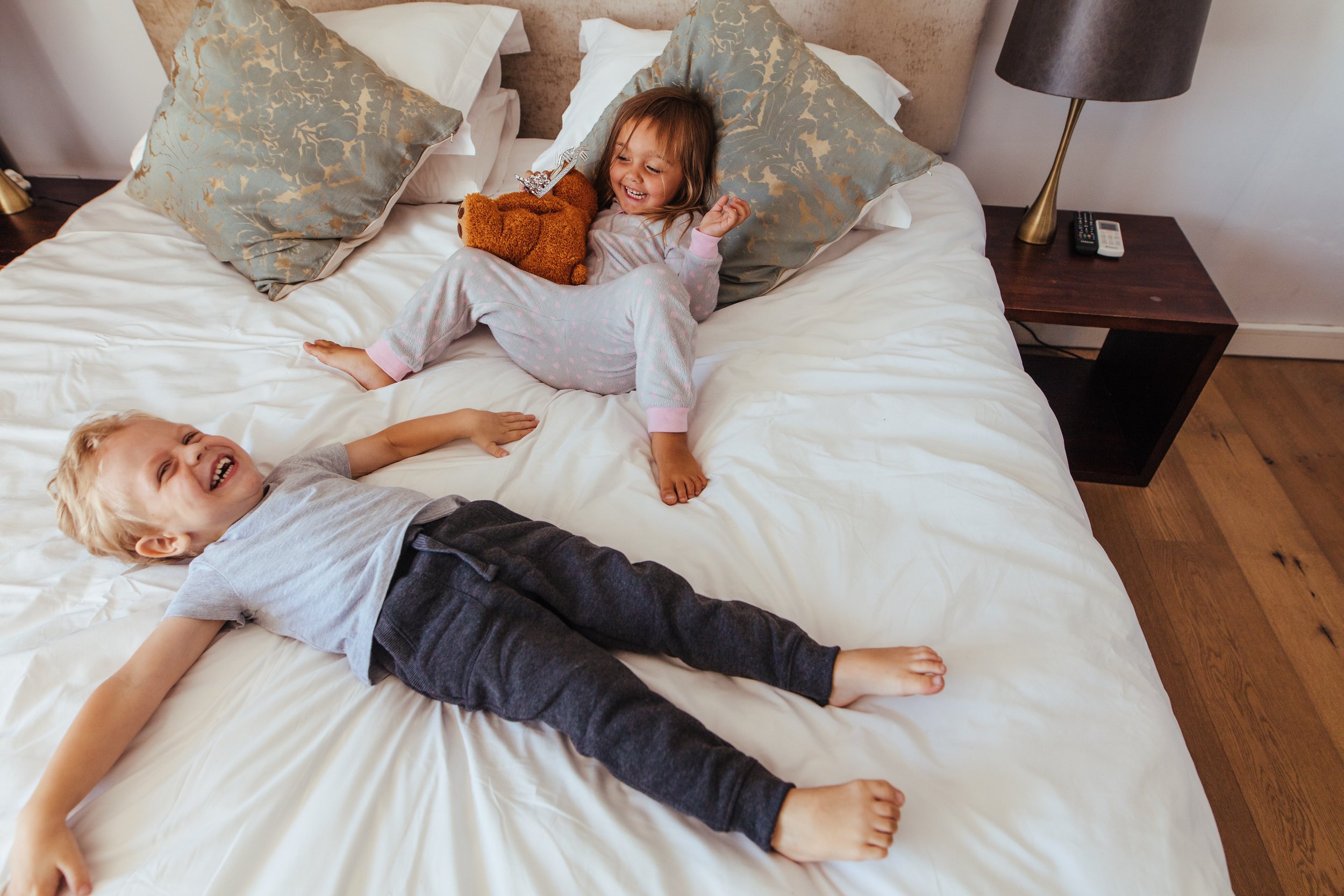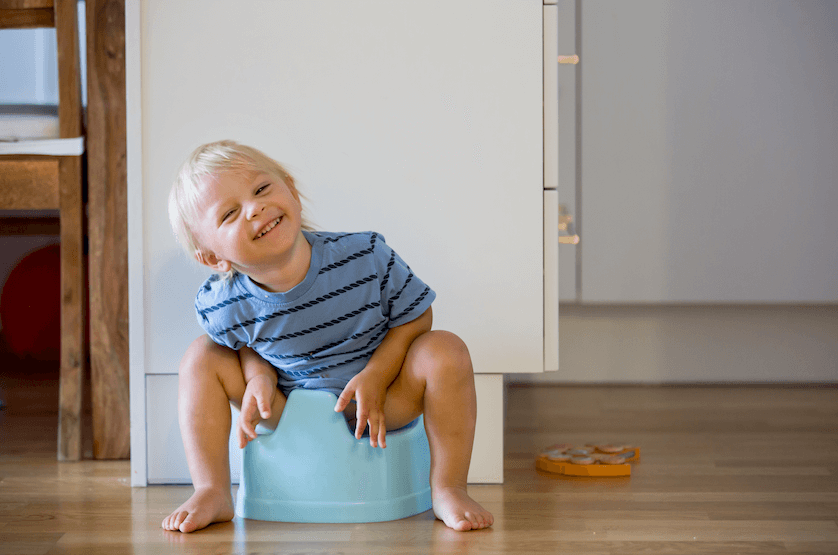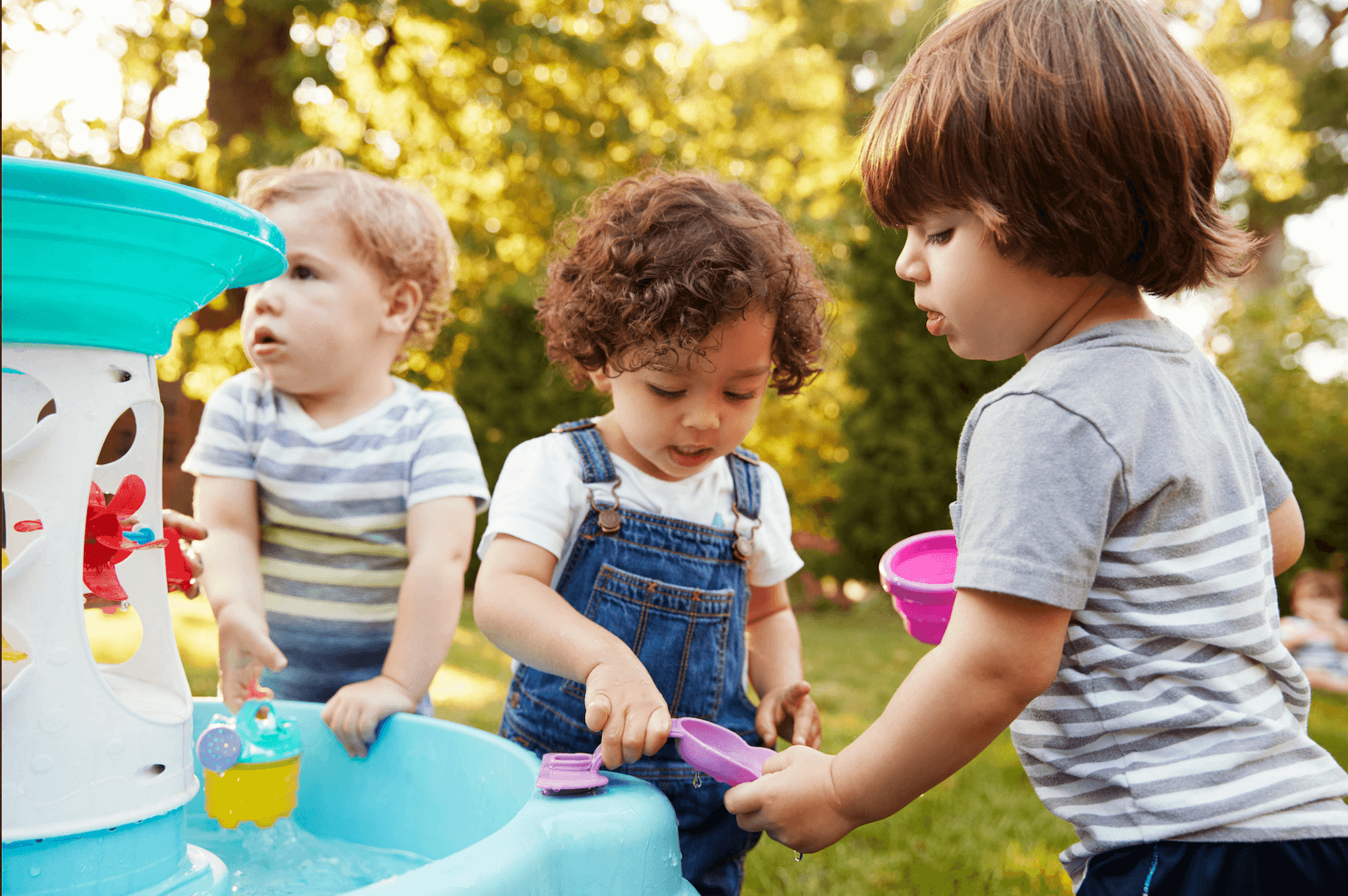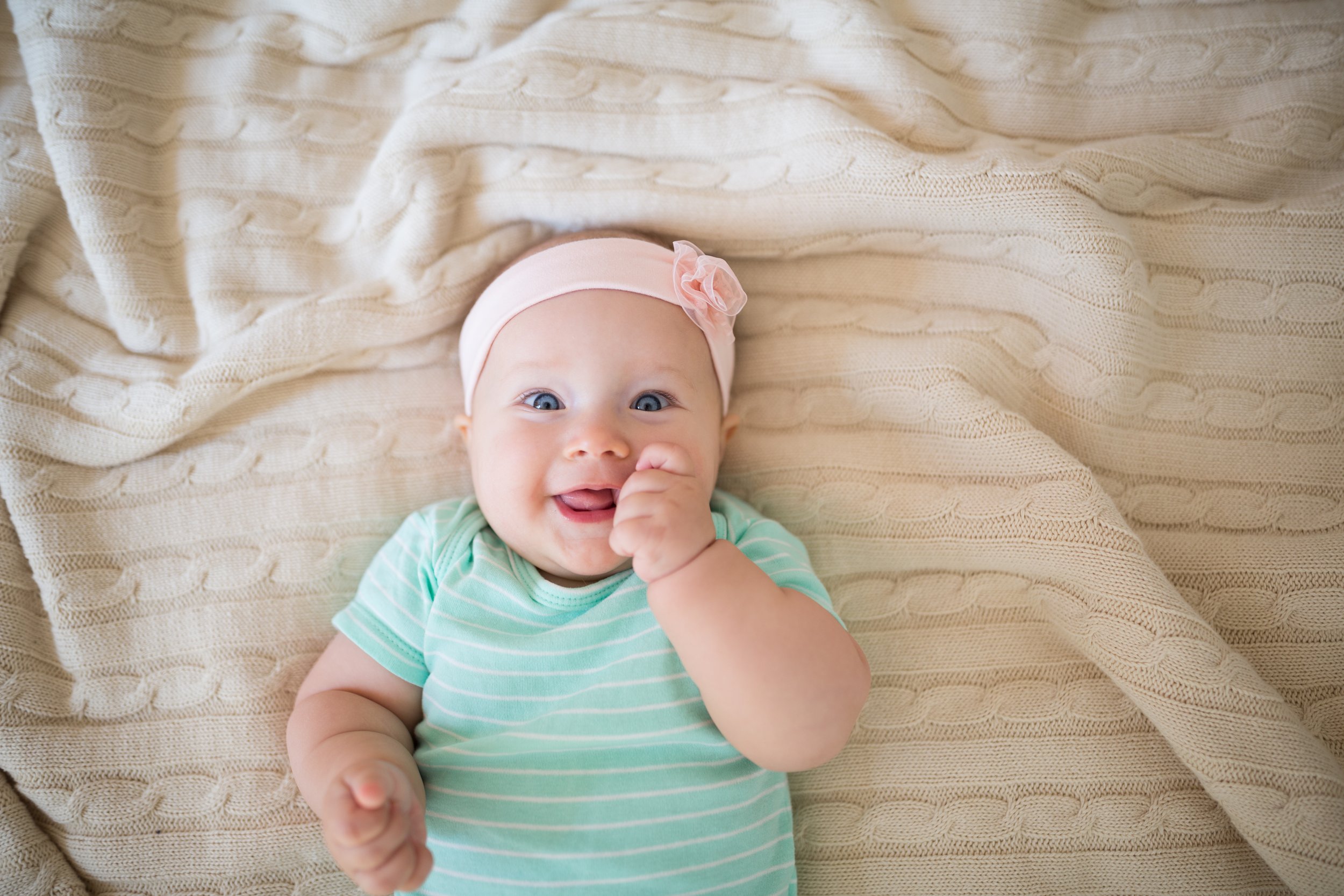Toddler Stages of Play
You might sometimes wonder, when will my baby start playing with toys? Watching your child’s play development can be very exciting!
It is important to remember that as babies and toddlers age, they progress through different stages of play. You can help your child play at different stages using our helpful tips. For now, keep reading for a sneak peek about what your baby’s play journey is going to look like.
In this post we’ll talk first about how toddlers develop play with objects and toys. Then we’ll walk through how toddlers learn to play with one another.
Related Post: How play and language develop together + how to choose the best toys
Stages of Play With Objects and Toys
For the purpose of this article, we are going to divide object play into 4 basic stages: Non-functional Play, Functional Play, Pretend Play, and Imaginary Play. The stages overlap and there are smaller stages within each stage, but we want to keep it easy to understand. Keep in mind that there are other types of play as well (such as physical play) but this article is focusing on the way children play with objects and toys.
Non-functional play (10-16 months):
This is the type of play that babies do. Banging on a surface, shaking, or throwing are ways a baby might interact with a single object. The child might also take two objects and bang them together, remove objects from where they are hidden in a container, and put objects back in a container. Although children might have preferences about what toys they like (blocks vs playing with plastic farm animals, for example,) a child in the non-functional play stage doesn’t play differently depending on what the toy is. They child doesn’t yet view the objects as being used a certain way.
Example of non-functional play: A 12-month-old puts objects inside a bowl and then takes them out and puts them in their mouth.
Functional play (14-24 months):
Eventually a child will start using familiar household objects the way they are designed. The child might bring the correct end of an empty cup or spoon to their mouth. They might take a comb and rub it on their head or take socks and touch them on their feet. The child isn’t pretending, but is showing you “look, I know how to use this thing!” First they will use the object on themselves, then they will do it with another person. Early functional play also involves toys that the child has observed someone else play with. They might push a car, put a ball in a basketball hoop, or push buttons on a toy. They aren’t thinking “I’m pretending this car is in a race!” or “I’m a famous basketball player and we are winning!” Instead, they are thinking “I saw my dad do this with this toy and now I’m doing it too.”
Example of functional play: A 16 month old watches their big brother push a large toy bus on the ground. Later they push the bus on the ground too. They find their daddy’s hat on the couch and try to put it on their own head because that’s what daddy does.
Pretend play (2-3 Years):
Pretend play is a broad category and is very exciting for families. Play starts having multiple steps (such as pouring pretend tea into a bowl, stirring it with a spoon, then feeding it to a stuffed animal.) At the beginning of pretend play, objects are usually closer to life size (such as feeding a large baby doll with a real bottle.) As children advance through pretend play, they can use smaller objects to engage in pretend schema (like playing with a character who lives in a small doll house.)
Example of pretend play: A toddler shows their mom their stuffed bunny. They say, “bunny owie!” and point to the bunny’s leg. They get out their vet kit and put a toy bandage on the bunny.
Imaginary play (3+ Years):
When children are in preschool, they will start to show complex play using imaginary ideas that are not reflected in a physical toy. For example, they might project thoughts/ feelings on their dolls or pantomime imaginary objects.
Example of Imaginary play: A preschooler comes out of their bedroom wearing a cape and holding a stick. They tell their mom that they are a wizard and are cooking potions. They wave their wand over an imaginary cooking pot and offer some imaginary soup to their mom.
How toddlers and preschoolers play with each other
Have you ever seen a pair of 18-month olds working together to build a stuffed animal zoo, pretending that one is a zoo keeper and the other sells tickets? Of course you haven’t. More likely the 18-month olds are busy playing their own thing, sometimes staring at each other awkwardly. Much like how play with toys evolves as children age, play with others is also a gradual process. For the purpose of this article, we are breaking down “play with others” into 6 stages. Keep in mind that an older child might still sometimes demonstrate earlier types of group play, depending on the situation and their personality. Ages for these stages vary widely as well.
Unoccupied Play (less than 18 months):
A child is playing alone and their play may seem disorganized or scattered while they explore their space. They may interact with objects briefly.
Example: A baby crawls over to a toy sheep that catches their attention. They briefly put the sheep in their mouth before noticing another toy elsewhere. They crawl around another child who is present and get the other toy.
(Less than 2 Years) Solitary Play:
A child is playing alone without reference to other children. Other children might be present, but the activities of those children are not reflected in the play of the solitary child. At the end of this stage a child will start observing other children while they play (Observational Play.)
Example: a child is sitting stacking blocks while another child plays with a toy kitchen.
(~2 Years) Observational Play:
A child who is playing alone observes other children in their play.
Example: A child who is stacking blocks on a rug looks up and watches another child playing with a toy kitchen.
(2+ Years) Parallel Play:
A child is playing alone, but is engaged in the same play as a neighboring child. They are not interacting with each other but they are using the same type of toy.
Example: Two children are standing near a toy kitchen. Both children have cooking pots they are filling with food, but they are not talking to each other.
(3+ Years) Associative Play:
The children are playing with the same set of toys and the play is loosely set around the same idea/materials. The children are now sometimes talking with each other about their play and they are sharing materials. The common actions will be relatively simple and won’t include a larger, shared complex idea.
Example: Two children are standing by the toy kitchen. They have a large cooking pot and are making a “soup.” They are talking about what to put in their soup. Pretty soon they are making a smoothie in a toy blender and are both finding fruits to put inside.
(4+ Years) Cooperative Play:
The play includes different roles, common goals, and can go on for a long time. In larger groups of children there will typically be one or two “leaders” directing the play of the group as a whole.
Example: Two children are standing by a toy kitchen and are playing restaurant. One child goes and gets an order from a parent, then comes back and tells the second child. They work together to cook the food, one making the sandwich and the other the drink. The first child then goes and brings the order to the parent.
Parallel play marks the first time that your little one is playing alongside other children, even if they aren’t playing with the same toys. Parallel play can be hard for some toddlers, so we’ve written a little extra about how you can help your little one with parallel play.
How do you introduce parallel play?
Parallel play is a “play with others” stage that begins around the age of 2 (see our post about play stages). Children will play near each other, but not with each other.
The best way to help your toddler learn to play with others is to make sure that they have lots of opportunities to be around other children. Younger children who have older siblings and cousins are at an advantage because they are able to watch children in other play stages before they play on their own. For children without siblings/ older cousins, some opportunities to meet other kids include going to a playground, free community activities at the library, daycare, or structured classes such as music or gymnastics.
When setting up playdates for toddlers, make sure that you have multiples of different toys so that each child can have their own set. For example, if you have a basketball hoop, make sure there are at least two balls. In addition, if you limit the number of different types of toys that are present, there is a greater chance that the two children will pick the same toy and play in parallel.
If the kids don’t interact with each other, don’t worry about it. Simply sharing space and observing another child is an important first step before a child starts to parallel play.
Here are some other questions that parents ask about toddler play:
-
Speech therapists always like to look at play to help them better diagnose what type of language delay a child might have. If a child’s play and receptive language skills are on track but the child isn’t talking, the therapist may call them a “late talker” or may monitor them for a speech production disorder (like apraxia of speech.) If the child’s play is delayed, it is more likely that their understanding and talking will be delayed too. If a child’s play is significantly delayed or noticeably atypical in some way, these might be traits of another developmental diagnosis, such as autism.
-
The way a child interacts with a toy can indicate what stage of development they are in and can help speech therapists and other developmental specialists know if a child is on track.
-
Have you ever seen a baby use a pretend kitchen to make you a “sandwich” for lunch? Neither have we. But just because babies don’t yet pretend doesn’t mean that they don’t play. Babies start to interact with objects intentionally at about 5-6 months. First, they simply bring objects to their mouths. Next they will shake the object, then start to bang objects on surfaces. Eventually babies can hold an object in each hand and bang them together. Finally, babies will start to have the objects interact together in a very simple way, such as putting one object inside another, opening a simple container to look for an object, or early object stacking. Babies don’t yet use the objects the way they are intended. For example, if you give a baby a comb they won’t use it on their hair, but they might mouth it and put it in a cup.
Babies transition to toddler play gradually. The 12-14 month age range is an exciting time for families because a baby might be close to walking, have a first word, but also will start on a more advanced play stage.
Written By: Stephanie Burgner-Vader, MA CCC-SLP
More From The Blog:
References List:
Casby, Michael W. Symbolic Play of Children With Language Impairment, A Critical Review. Journal of Speech, Language, and Hearing Research. Jun 1997 https://pubs.asha.org/doi/10.1044/jslhr.4003.468
Kylie Rymanowicz, M. S. U. E. (2021, June 1). The power of play – part 1: Stages of play. Early Childhood Development. Retrieved February 22, 2023, from https://www.canr.msu.edu/news/the_power_of_play_part_1_stages_of_play
Kylie Rymanowicz, M. S. U. E. (2021, June 1). The power of play – part 3: Types of play. MSU Extension. Retrieved February 22, 2023, from https://www.canr.msu.edu/news/the_power_of_play_part_3_types_of_play
Parten MB. Social Participation among Preschool Children. Journal of Abnormal and Social Psychology. 1932; 27 (3): 243–269.
Westby, Carol E. Assessment of Cognitive and Language Abilities Through Play. Language, Speech, and Hearing Services in Schools. Jul 1980. https://pubs.asha.org/doi/10.1044/0161-1461.1103.154#
© 2020-2025. Stephanie Keffer Hatleli, MS CCC-SLP. All Rights Reserved.The content offered on ToddlerTalk.com is for informational purposes only. Toddler Talk is not engaged in rendering professional advice, whether medical or otherwise, to individual users or their children or families. No content on this site, regardless of date, should ever be used as a substitute for direct medical advice from your doctor, speech language pathologist, or other health professional. By accessing the content on ToddlerTalk.com, you acknowledge and agree that you are accepting the responsibility for your child’s health and well-being. In return for providing you with information related to home speech and language practice, you waive any claims that you or your child may have as a result of utilizing the content on ToddlerTalk.com.


